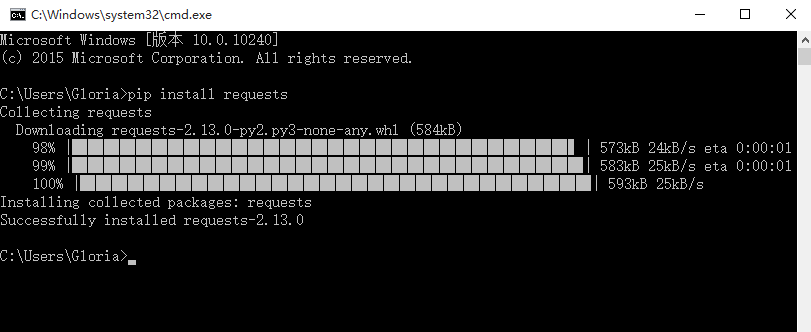在做接口测试的时候都会用到很多工具,如postman、jmeter、soupUI等工具,除了这些工具外,我们也可以用python的第3方库requests来做接口测试。
request简介
requests是python实现的简单易用的HTTP库,属于python的第3方库,通过pip进行安装使用。
requests中文文档:https://2.python-requests.org//zh_CN/latest/user/quickstart.html#
requests安装
1.打开cmd
2.通过pip进行安装
# 安装requests
pip install requests

requests发送get请求
源码:
def get(url, params=None, **kwargs): r"""Sends a GET request. :param url: URL for the new :class:`Request` object. :param params: (optional) Dictionary, list of tuples or bytes to send in the body of the :class:`Request`. :param **kwargs: Optional arguments that ``request`` takes. :return: :class:`Response <Response>` object :rtype: requests.Response """ kwargs.setdefault('allow_redirects', True) return request('get', url, params=params, **kwargs)
1.首先导入requests模块
2.选择get方法请求地址:https://www.cnblogs.com/qican/
3.可以查看请求的返回内容
# coding:utf-8 # 导入模块 import requests # 请求地址 url = 'https://www.cnblogs.com/qican/'
r = requests.get(url) # 请求返回内容 text = r.text print(text)

4.请求携带参数params
5.请求地址:http://httpbin.org/get?
6.请求参数书写以字典形式编写如{ "name": "requests" }
# coding:utf-8 # 导入requests模块 import requests # 携带参数 params = { "name": "request", "name1":"python" } # 请求地址 url = 'http://httpbin.org/get?' r = requests.get(url,params=params) text = r.text print(text)
代码结果: { "args": { "name": "requests", "name1": "python" }, "headers": { "Accept": "*/*", "Accept-Encoding": "gzip, deflate", "Host": "httpbin.org", "User-Agent": "python-requests/2.21.0" }, "origin": "116.247.112.151, 116.247.112.151", "url": "https://httpbin.org/get?name=requests&name1=python" }
通过观察,可以发现最后的url地址已经被更改成了name=requests和name1=python
requests请求post
源码:
def post(url, data=None, json=None, **kwargs): r"""Sends a POST request. :param url: URL for the new :class:`Request` object. :param data: (optional) Dictionary, list of tuples, bytes, or file-like object to send in the body of the :class:`Request`. :param json: (optional) json data to send in the body of the :class:`Request`. :param **kwargs: Optional arguments that ``request`` takes. :return: :class:`Response <Response>` object :rtype: requests.Response """ return request('post', url, data=data, json=json, **kwargs)
1.导入requests模块
2.选择post方法请求:http://apis.juhe.cn/simpleWeather/query
3.输入参数格式{”name“:”value“}
# coding:utf-8 import requests # 导入模块 url = 'http://apis.juhe.cn/simpleWeather/query' # 请求地址 # 请求参数 data = { "city":"上海", "key":"331eab8f3481f37868378fcdc76cb7cd" } r = requests.post(data=data,url=url) print(r.text)

返回值其他内容
r.text # 返回全部内容 r.url # 返回的url地址 r.content # 返回解码后的内容 r.cookies # 返回cookies r.headers # 返回携带的请求头 r.status_code # 返回状态码 r.json() # 返回json格式